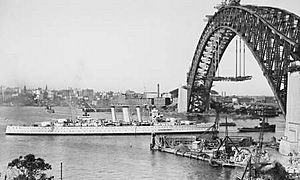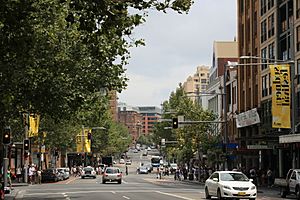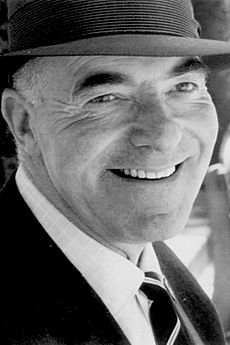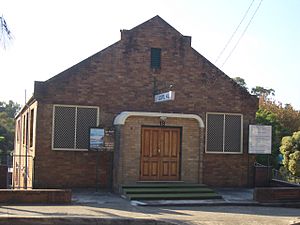Frank Jenner facts for kids
Quick facts for kids
Frank Jenner
|
|
|---|---|

Frank Jenner while he was a sailor on HMAS Canberra
|
|
| Nickname(s) | Bones |
| Born | 2 November 1903 Southampton, Hampshire, England |
| Died | 8 May 1977 (aged 73) Kogarah, New South Wales, Australia |
| Buried |
Woronora Lawn Cemetery
|
| Allegiance | United Kingdom United States Australia |
| Service/ |
Royal Navy United States Navy Royal Australian Navy |
| Spouse(s) | Jessie Jenner |
| Relations | Ann Carruthers (daughter) |
Frank Arthur "Bones" Jenner (born 2 November 1903 – died 8 May 1977) was an Australian Christian who shared his faith with many people. He was known for asking strangers on George Street in Sydney, "If you died within 24 hours, where would you be in eternity? Heaven or hell?"
Frank was born in England. When he was 12, he got a sickness called "sleeping sickness," which caused him to be very sleepy for the rest of his life. This condition is known as narcolepsy.
He joined the Royal Navy, then the United States Navy, and later the Royal Australian Navy. In 1937, Frank became a Christian. For 28 years, he talked to people about his faith. He spoke with over 100,000 people in total. One person he spoke to was Noel Stanton, who later started a Christian group called the Jesus Army. Frank didn't know how much of an impact he was making until 1953, when a pastor told him that many people he had spoken to had become Christians.
Contents
Early Life and Challenges
Frank Arthur Jenner was born on 2 November 1903 in Southampton, England. His father owned a hotel and used to be a ship captain. Frank had four brothers. As a boy, Frank was a bit rebellious.
When he was 12, during World War I, he was sent to work on a training ship for boys who misbehaved. At 14, while his ship was in West Africa, a tsetse fly bit him. This bite gave him "sleeping sickness," also called African trypanosomiasis. He fell into a coma for 15 days but eventually got better. From then on, he suffered from extreme sleepiness during the day, which was diagnosed as narcolepsy. This meant he could never drive a car. After the war, he returned to England.
After some time, Frank joined the Royal Navy. However, he left the navy without permission in New York City, United States. Soon after, he joined the United States Navy. During this time, Frank learned to gamble and became very fond of a dice game called craps. He started carrying a rabbit's foot for luck and would rub it while playing. His shipmates began calling him "Bones," a nickname that stayed with him throughout his navy career.
When he was 24, his work with the US Navy brought him to Australia. He again left the navy without permission, this time in Melbourne. There, he met Charlie Peters, who invited him to his home for a meal. Frank met Charlie's daughter, Jessie, who was 23. Jessie and Frank married a year later, on 6 July 1929. They continued to live in Melbourne, and Frank joined the Royal Australian Navy. He was one of the sailors who traveled to England to bring the ship HMAS Canberra back to Australia. In 1937, he officially left the navy.

In 1939, when World War II started, Frank was called back to duty. Because of his narcolepsy, he was given jobs on land in Sydney. He did secret missions and delivered important sealed orders. After the war, he left the navy and became a janitor for IBM, a large technology company.
Becoming a Christian
In 1937, Frank saw a group of men from a Christian group called the Exclusive Brethren preaching outdoors on Collins Street in Melbourne. Frank joked with the preacher, saying he would listen to the "good news" if he could share some good news first. The preacher agreed, so Frank taught the group how to play craps right there on the street!
One of the Christian men invited Frank to his home for tea and told him about the Christian message, often called the "gospel" or "good news" about Jesus. Frank decided to become a Christian. When he went home, he told his wife, Jessie, that she needed to become a Christian too. Jessie thought Frank had gone a bit crazy.
At this time, Frank was gambling a lot and not earning enough money for his family. Jessie and their young daughter, Ann, moved away to live on a farm. Jessie said she would only return when Frank seemed normal again. Frank also tried to tell Jessie's brothers they needed to become Christians, which made them angry. They even got into fights and stopped talking to Frank. He wrote to his family in England about his new faith, but they didn't reply.
Later in 1937, Jessie became very sick. While being cared for by a Christian family, she also became a Christian. Before the end of that year, Frank and Jessie started living together again. Frank stopped gambling, but he often lost his jobs because he would talk about his faith at work and then get fired.
In 1939, Jessie got a stomach ulcer. People thought it was caused by stress, and the family's money problems were very stressful. So, Jessie and Ann moved to India to live with Frank's aunt. Ann went to school there until she was ten. Once Jessie was better, they returned to Sydney.
Frank would wake up early, at 5 AM, to pray every day. In the 1940s, Frank joined a different Christian group called the Open Brethren. For the rest of his life, he went to Open Brethren churches in Sydney. Sometimes, people at church didn't understand his narcolepsy and thought he was falling asleep because he didn't respect God. Frank also liked to work with other Christian groups, like The Navigators and Baptists, even though his church didn't always approve.
Sharing His Faith
Frank felt very thankful to God for becoming a Christian. He decided to talk to ten different people every day about his faith. For 28 years, until he became sick with Parkinson's disease, Frank did this. He probably spoke with over 100,000 people. Hundreds of them showed interest in becoming Christians.
He carried small Christian booklets, called religious tracts, in his shirt pocket, where he used to keep his rabbit's foot. He often gave these to people. He also kept a card with a Bible verse, Philippians 4:13, which says, "I can do all things through Christ who strengthens me." This verse gave him courage. Frank usually wore a white shirt, black shoes, and trousers, sometimes with a navy coat.

He mostly shared his faith on George Street, Sydney. He would ask many people the same question: "If you died within 24 hours, where would you be in eternity? Heaven or hell?" If they were willing to talk, he would invite them to his home or a local church. This question became known as "the Frank Jenner question." Frank was most active during World War II. On Saturday nights during the war, he would invite groups of sailors to his home for a short Christian service.
One person Frank asked his question was Noel Stanton, a sailor from England. Noel couldn't stop thinking about their meeting for months. The next year, he became a committed Christian. Noel later started the Jesus Army in England in 1969.
In 1945, Frank met Norrie Jeffs, a sailor who had just returned from a mission. Frank asked his question, and Norrie said he was already a Christian. Frank invited Norrie to his house, where Norrie met other visitors, including the woman who would become his wife.
In 1952, Frank met Ian Boyden, a man serving in the Royal Australian Air Force. After a short talk, Ian accepted Frank's invitation to a church service. There, Ian decided to live as a Christian, and he continued to do so for over fifty years. Many other people had short talks with Frank and became Christians. But Frank didn't know that any of them had continued to follow Christ until 1953.
Another Christian speaker, Dave Rosten, tried to copy Frank's method but was punched by the first person he spoke to! He decided Frank's way of sharing his faith wasn't for everyone. In 1947, Frank asked his question to Angus Carruthers. Angus said he was a Christian. Frank invited Angus to his home, where Angus met Frank's daughter, Ann. Angus and Ann married three years later.
The Story Spreads

Reverend Francis Dixon was a pastor in England. His youth pastor, Peter Culver, had become a Christian after meeting Frank Jenner on George Street in 1945. In 1952, Dixon heard Noel Stanton's story, which also included meeting Frank. Dixon realized that both Peter and Noel had become Christians because of the same man. The next year, Dixon heard two more British sailors tell similar stories at his church.
Dixon then traveled to Australia, hoping to find this man, though he didn't know his name yet. In Adelaide, Dixon shared the stories of Peter and Noel. A man named Murray Wilkes then told Dixon that he too had become a Christian after Frank asked him the question on George Street. In Perth, Dixon heard another similar story.
Finally, in Sydney, Dixon asked if anyone knew a man who asked strangers on George Street about heaven or hell. He was told about Frank Jenner. Dixon visited Frank at his home and told him about all the people he had met who had become Christians because of Frank's efforts. Frank, who was 50 years old, had never known that even one person he spoke to had continued to be a Christian. He cried when he heard the news.
After returning to England, Dixon found even more people who had become Christians because of Frank in different countries. By 1979, Dixon had found ten such people. It was because of Francis Dixon that Frank Jenner's story began to be told widely. Dixon's wife, Nancy, wrote a story about Frank called "The Jenner Story."
Later Life and Legacy
In his later years, Frank developed Parkinson's disease and retired from his job at IBM. With money Jessie inherited, they moved to Bexley in 1953 and started attending Bexley Gospel Hall. Towards the end of his life, Frank also developed dementia. He was confined to bed for six months. He was then diagnosed with colorectal cancer and died on 8 May 1977, at the age of 73. Because he had become friends with many police officers, his body was given a police escort to his burial. His wife died two years later.
While Frank was alive, very few people knew about him, and his impact was largely unnoticed. After he died, however, stories about his efforts to share his faith spread widely. Many of these stories were passed down by word of mouth, and some details became mixed up or changed. For example, many storytellers said Frank was small with white hair, but his family said this wasn't true.

In 2000, Raymond Wilson wrote a book called Jenner of George Street: Sydney's Soul-Winning Sailor to tell Frank's story accurately. Frank's family found it upsetting to hear different versions of his life story, so they gave Wilson all the information he needed. Wilson wrote that Frank was "eccentric" and not what people might expect a hero to be, but that his life showed how God's "power is made perfect in weakness" (from the Bible, 2 Corinthians 12:9). Wilson said Frank's question was similar to that of Arthur Stace, another Australian who wrote "Eternity" on sidewalks to make people think about their future.
Even after Wilson's book, some different stories about Frank continued to spread. In some accounts, Frank is called "Mr. Genor." One such story was shared by Ray Comfort and then repeated in a 2006 book by Ché Ahn. Ahn's story describes Frank as a "little white-haired man" and says he died two weeks after meeting Dixon, which is not true. Wilson's book states that Frank died more than 20 years after Dixon told him about the people who became Christians because of him.
In 2013, Gary Wilkinson made a documentary film called The Frank Jenner Question, which included interviews with Frank's daughter and people who became Christians because of him. Claire Goodwin also encouraged people to be like Frank in her 2013 book, Compelled to Tell.
Images for kids
-
Jenner's wife and daughter moved to India to avoid the stress of poverty arising from Jenner's frequent unemployment, but they eventually returned to him on SS Oronsay.




